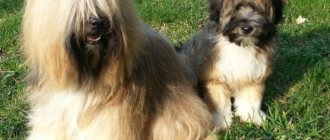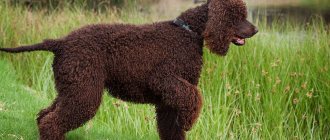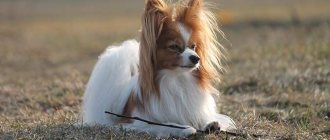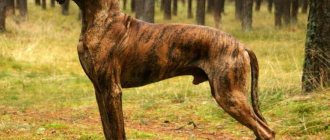a brief description of
- Other names: Tibetan Spaniel, Simkhyi, Tibbie, tibbie.
- Height: 25-26 cm.
- Weight: from 4.0 to 7.0 kg.
- Color: Any coat color is acceptable, white spots on the paws are acceptable.
- Coat: double coat with thick undercoat, thick, silky, long along the neck and tail.
- Life expectancy: up to 16-18 years.
- Advantages of the breed: Tibbies have a loyal character with a sufficient level of intelligence. A characteristic feature of the breed is considered to be an active life position and courageous actions.
- Difficulties of the breed: Dogs are stubborn and overly self-confident. A high level of energy forces the owner to spend more time walking or playing active games.
- Price: up to 1000 euros.
Health and life expectancy
Tibetan spaniels are long-lived dogs, often living up to 16-18 years, and sometimes more. The average life expectancy is 14-15 years. In general, dogs have good health, but are not free from hereditary diseases:
- Cardiomyopathy;
- Allergy;
- Ophthalmological diseases (progressive retinal atrophy, primary lens luxation, entropion, districhiasis);
- Hip dysplasia;
- Dislocation of the kneecap;
- Nephropathy and urolithiasis;
- Incorrect bite, incomplete dental formula;
- Cryptorchidism.
Tibetan Spaniels require standard veterinary preventive measures.
In addition, it is advisable for your dog to undergo an annual medical examination, which will allow timely detection of the disease.
History of the origin of the breed
A small decorative dog, resembling a large Pekingese in appearance, belongs to the Tibetan spaniel breed. It is possible that the Pekingese played a certain role in the development of the breed, or is considered the closest relative of the Tibby, but there is so little information about the origin of the Tibetan Spaniel that either hypothesis may apply.
The first mention of small dogs serving in a Tibetan monastery was mentioned around the 8th century AD. Dogs were given a sacred role when the monks performed their rituals - tibbies turned prayer wheels.
Over time, the Sacred Supreme Law underwent changes, and dogs were removed from their positions. But they remained in the monasteries, where they were very careful about breeding the breed, not allowing inbreeding with other breeds.
Trade relations between Tibet and China were built on the exchange of goods, which included dogs. It was during this period that dog breeders in China received the Pekingese, which itself could participate in the production of the Tibetan spaniel along with the Shih Tzu and pugs.
The European cynological community became acquainted with the Tibby only at the end of the 19th century. Tibetan spaniels were introduced to dog lovers in the British kingdom only in 1898 as debutants at the annual canine exhibition. And some representatives of the breed came to England only in 1905.
For a long time, Poda remained little known, and even at the present stage, Tibbies are in little demand - they are not well known, since the owners do not seek to popularize the breed. The breed was first described in Europe in 1934, after which the standard was revised several times.
At the present stage, the Tibetan Spaniel breed standard, approved by the International Canine Federation in 1997, is in force.
Description of the breed
The Tibetan Spaniel is a very rare breed. They still occupy the last positions in the ranking of popularity in the US and EU countries.
Tibetan spaniels are one of the oldest breeds, which have been known since the 8th century AD. e. Since time immemorial, they have served in the monasteries of Tibet, turning prayer wheels and warning larger guard dogs - Tibetan mastiffs - of the approach of intruders with ringing barks. They were considered sacred, they could not be sold, but could be given as a gift. This is how these dogs came to China.
Europeans learned about "tibby" only in 1890. But representatives of the breed did not become widely known until the 1920s, until one of the English breeders became seriously interested in them. He was actively involved in the development of Tibetan spaniels, but the Second World War dashed all efforts. It was only in 1957 that the Tibetan Spaniel Association (TSA) was created, thanks to which a couple of years later these dogs were recognized by the English Kennel Club. Until now, the breed is considered one of the rarest and smallest.
Standard
The movements of the Tibetan Spaniel when walking or running are confident and light, the head is proudly raised.
In purebred individuals, during physical activity the back should not sag, the croup should not rise too high, and the paws should not overlap each other. Tibetan spaniels have a modest size and low body weight. The height at the withers for males reaches a maximum of 26 cm, for females - 24 cm. And the weight varies from 4 to 6.8 kg.
Table 1. Body features of Tibetan spaniels
| Sign | Short description | Disqualifying defects and shortcomings |
| Head |
|
|
| Muzzle |
|
|
| Eyes |
|
|
| Nose |
| |
| Lips and jaws |
|
|
| Ears |
|
|
| Frame |
| |
| Neck |
| |
| Back |
| |
| Limbs |
|
|
| Tail |
|
Coat and colors
The coat of Tibetan spaniels is silky, with a dense structure and thick undercoat. Guard hairs of medium length, thin. Longer hair in the area of the ears, sternum, tail and riding breeches. Males differ from females by having a pronounced “lion’s” mane.
The color palette of the breed is very diverse: from black to white and cream. Various combined colors with tints and smooth transitions of tones are also allowed. Breeders especially appreciate the uniform golden color without a dark mask.
Golden color without a black mask on the face is especially valued by breeders
White markings on different parts of the body are welcome and are considered an advantage of the individual, especially if it is black in color. Each of these light inclusions carries a certain meaning, depending on its location:
- the spot on the tip of the tail is associated with the puppy’s mischief and cunning;
- on the forehead - with the mark of Buddha;
- on the chest - with a symbol of a pure heart.
Pros and cons of character
The Tibetan Spaniel is very active and needs a lot of exercise. This breed is not very suitable for elderly or busy people who are unable to devote most of their time to their pet.
Today, the main purpose of the Tibby is to be a companion dog, man's best friend. The watchdog functions of the breed have faded into the background, but its representatives are no worse than their ancestors in being able to protect the house despite their modest size. They are wary of strangers and very courageous; if necessary, they are ready to repel the aggressor, warning their owners of the approaching danger with a ringing bark.
When the dog is not busy guarding the territory, it is cheerful, playful, energetic and cheerful. Her noisy activities require maximum free space and a minimum of restrictions. If you constrain a dog or do not allow it to frolic to its fullest, then a good-natured animal can become a hunted and embittered animal with a broken psyche.
"Tibbies" are very active and playful. They don't stop moving even at home, so they need to be given space to play.
Tibetan Spaniels are very demanding of their owner's attention. They don't like to be left alone for a long time. In return, they are ready to repay with extraordinary devotion and affection not only towards the owner, but also towards members of his family.
The breed has a good level of intelligence and good memory of commands. But in this barrel of honey there is also a fly in the ointment - excessive willfulness and desire for independence. Even with very careful training, the dog will be guided throughout its life by its own ideas when assessing the situation and make decisions independently.
All the advantages and disadvantages of the “tibby” are concentrated in its contradictory character, in which they coexist:
- exceptional devotion and desire for independence;
- good nature and self-will;
- courage and recklessness;
- lack of aggression, anger and stubbornness.
Life expectancy and susceptibility to disease
Tibetan spaniels cannot be called a disease-resistant breed. They require careful care for good health.
The average life expectancy is 12 years . With good care, they can live up to 15 years. There is no need to talk about the exceptional health of the representatives of the breed, because any violation of the rules of maintenance can lead to irreversible consequences and the pet being affected by various diseases. Among them, the most commonly observed are the following:
- Food allergies. It is treated with immunomodulatory and histamine drugs and diet.
- Dermatitis and other skin diseases. It is necessary to use antiseptic, fungicidal, antihistamine, immunostrengthening agents, antibiotics, and physiotherapy.
- Hip dysplasia. Anti-inflammatory, antispasmodic drugs, and chondroprotectors are used for treatment. In particularly severe cases, surgical intervention is required.
- Intervertebral hernia, back pain and other lesions of the musculoskeletal system. A temporary restriction of the animal's physical activity is required, conservative therapy (with non-steroidal anti-inflammatory drugs to reduce swelling of the tissues around the spinal cord and analgesics), in extreme situations - surgery to excise tissues that exert mechanical pressure on the spinal cord, or implantation of an implant that will serve as a replacement worn out intervertebral disc.
- Diseases of the respiratory system, including shortness of breath. With respiratory shortness of breath, the dog needs relief of symptoms, supply of oxygen to the body and further therapy depending on the diagnosis. For cardiogenic, X-rays, ultrasound, tests for hormones and parasite infection, and blood/urine tests are prescribed. To eliminate pain, painkillers are used; for pulmonary edema, diuretics and anti-inflammatory drugs are used.
- Angina pectoris, heart valve dysfunction. Pain during angina attacks is relieved with analgesics, and anticoagulants are used to eliminate thromboembolic complications. A specialist may prescribe cardiac glycosides and mineral and vitamin supplements. The animal needs complete rest and absence of stressful situations.
Purpose
, small dogs - Tibetan spaniels - performed regular guard duty The dogs were placed on a hill so that they could see the surrounding area around the monastery. The dogs reported any intruded foreign elements immediately. Their sonorous barking could be heard loudly from the heights.
Tibbies served a warning function, and the territory was guarded by taciturn Tibetan mastiffs, scaring away uninvited guests with their ferocious appearance and monstrous size. This is how the peace of the holy lamas was protected.
In addition, tibbies were used as living hot water bottles, warming the beds of saints with hot bodies. Tibetan spaniels were also assigned to the sacred drums. The dogs were required to spin movable structures during the ritual of sacred rites and reading prayers.
History of origin
The Tibetan Spaniel is an ancient breed from Asia. According to some assumptions, the ancestors of the breed are Pekingese, Shih Tzu and pugs. According to others, Pekingese descended from spaniels. The first mentions of similar dogs date back to the 8th century AD. These dogs lived among monks in the highlands of Tibet, where they performed important functions. They sat on a hill and monitored the situation outside the monastery, warning of danger approaching the walls. Their ringing bark was followed by Tibetan mastiffs, who frightened the enemies with their menacing appearance and terrifying size. In addition, small dogs served as living hot water bottles in the beds of ministers. In temples they were assigned a sacred task; spaniels spun special drums with prayers at the time of religious rituals. Representatives of the breed were bred only within the walls of the monastery. Crossing with other breeds and incest were not allowed. Therefore, the Tibetan spaniel has survived to this day without major changes.
It was impossible to buy a pet. They were presented in exceptional cases as a gift or gift.
The first representatives of the breed appeared in Europe only at the end of the 19th century. Since then and to this day, the breeding and distribution of the breed has not been intensive enough. Therefore, even now the Tibetan spaniel is a rather rare breed.
The latest standard was approved by the International Canine Federation in 1997.
Character
Almost everyone who has interacted with Tibetan spaniels notes high intelligence and special friendliness towards those with whom the tibby was previously acquainted. The little dog treats strangers with cold distrust.
In a dog’s gaze, if you are unfamiliar, you can read a range of negative emotions from contempt to disgust. Tibby adores family members and endures forced separation extremely painfully.
These small decorative dogs are endowed with simply monstrous energy, since such a state cannot be called simply mobility. This is a pulsating clot of energy that needs regular release. Therefore, even a puppy needs to be walked a lot and effectively with games and elements of the initial training course, although these dogs are not obedient enough, but they are quite independent and willful.
The character of the Tibetan Spaniel manifests itself with the birth of the puppy. But they are not aggressive and do not bite, but they can talk about a soul overflowing with feelings for hours. Yes, so that the whole neighborhood is aware of the matter.
Tibbies are apathetic when it comes to training, and this is the biggest problem of the breed. To make a Tibetan spaniel into a companion dog, you need to put in a lot of effort, energy, time and perseverance. They begin to raise a dog from the “crawlers” age, exposing it to the process of socialization as early as possible.
Choosing a puppy
You can plan to move your puppy to a new apartment only after reaching 8 or 12 weeks of age. By the age of two and three months, puppies have completed their quarantine periods for their first mandatory vaccinations.
When choosing a puppy, they are guided not by the appearance of the baby, but by his parents - how well they correspond to the breed standard. The buyer's interest in the parents' health certificates is quite justified, and the breeder must provide them without fail . Otherwise, the stories that these are very strong dogs and practically do not get sick can be considered unfounded.
The puppy's health is indicated by its activity. He is extremely playful, active and inquisitive. He has a fairly long body, a dome-shaped head, a flattened muzzle and a flat back.
A swollen belly indicates possible damage to the puppy’s gastrointestinal tract by helminths. Don’t be afraid to ask the breeder if the deworming procedure was carried out and how long ago it was carried out.
Expressive and wide-set eyes should be clear, as should the ears. Overshot - a slight protrusion of the lower jaw above the front - is considered a characteristic feature of the breed. The color can be varied, but the coat is clean, without harmful odors and ammonia odors.
For Tibetan Spaniel puppies, the price is determined not by age or parental merits, but by gender. As a rule, females are much more expensive than males. This is due to the complaisance, calmness and moderate obstinacy of girls, unlike boys. Since the breed is considered extremely rare, the cost of a puppy varies around 1000 euros.
Breed standards
The Tibetan Spaniel is a small breed, but you will often hear that it is a “big dog in a small body.”
Size
Tibetan spaniels are miniature dogs. The height at the withers for males reaches 27 cm, for females - 24 cm. Weight - from 4 to 7 kg.
You can read about other small dogs here:
It is necessary to monitor the weight of the spaniel, as it must have a medium bone structure
Wool
Since the Tibby came to us from Tibet, where temperatures are extremely low, nature initially made sure that the dog did not freeze. She has a two-layer coat: a silky outer coat and a thick undercoat. The hair is short on the face and front legs, medium on the body, and longer on the hips and ears.
The color of the spaniel is the most varied: golden, black, black and brown. The standard provides for any options, but dogs with a white spot on the chest are especially valued. According to beliefs, this is a symbol of a pure heart. And the white mark on the forehead is the sign of Buddha. But there is also a negative sign: a snow-white tail. He talks about thieves' tendencies.
This dog is very popular in Europe. 200–250 tibbies are presented at exhibitions. In Russia, the situation with this is worse; usually about 15–20 dogs are recruited.
Photo gallery: Tibetan spaniel color
Golden and white is a fairly common color among Tibetan spaniels.
The black color is valued among Tibby lovers, especially if there is a white spot on the chest
There are also tri-colored Tibetan spaniels, the sign says that this is good luck
Muzzle
The Tibby's muzzle is of medium length and flattened. There shouldn't be any wrinkles on it. The lower jaw is wide and deep. The eyes are expressive, oval in shape. The rims of the eyes, like the nose, are always black.
Table: brief characteristics of the breed
| Height | Weight | Color | Wool | Lifespan |
| 24–27 cm | 4–7 kg | Brown, black, white and various crosses | Two-layer, thick, silky | 16–18 years old |
Choosing a puppy
The puppy can be adopted at 8-12 weeks of age. The breeder must complete all vaccinations.
Look at the baby, he should have a flattened muzzle, wide-set eyes, a straight back, hanging ears, clean fur.
If the puppy is playful, active and inquisitive, then most likely he is healthy.
Ask the breeder for parent certificates . Without these documents there is no certainty of compliance with the breed standard. If a small Tibby has a swollen belly, this indicates the presence of worms. Don't be afraid to ask the breeder when he got rid of parasites.
A Tibby's health is indicated by his activity; he should be playful and inquisitive.
Nicknames for dogs
The dog moves to a new home with the name given by the breeder. The entire litter is assigned one letter of the alphabet in accordance with the nursery stud book. The new owner can keep the name given to the dog, but can also rename the puppy.
There are no barriers to assigning a pet name to a puppy, except that in the show annals the dog will appear under an official name with the factory prefix of the kennel.
At one of the exhibitions, a pretty, intelligent girl with the sonorous name Manya attracted attention. During the award ceremony, her official name was heard - Mirabelle Fon, and a long, but very beautiful English-language prefix from some diamond mines of almost King Solomon.
And in everyday life it’s the charming Manya, or Zach, Chris, Filya and numerous pet names for wonderful pets. The main thing is names that are sonorous, easy to pronounce and loved by dogs.
Care and maintenance
Tibbies are indoor dogs . They are not intended for aviary keeping. Even for such a restless breed as the Tibetan spaniel, there must be a place in the house where the dog will feel alone and can sleep.
If a dog is purchased on the eve of the winter season, then the puppy can be taught to use a litter box, and as the weather warms up, devote time to walking outside. But it is better to immediately accustom your pet to warm clothes - overalls and slippers, which he is destined to use every time winter comes.
Walking is very important for active spaniels. Walks should be long and involve maximum physical activity. At first, be sure to praise after each bowel and bladder release. .
Dogs should not be prohibited from actively playing with their own kind, even if it seems that the game has dragged on significantly. The Tibby's irrepressible energy must be completely exhausted. When walking in crowded places during the socialization stage, the dog must walk on a leash.
Caring for your pet is simple and involves careful, regular brushing of the fur. One procedure per week is enough to keep your dog looking great. This does not apply to show dogs, which are brushed much more often. Frequent bathing is contraindicated for dogs. But if such a need arises, the wool is immediately dried with a hairdryer or a special compressor.
Ears require constant care. Ears are cleaned twice a week, and the auricle is checked daily. The eyes are also examined every day, but are periodically washed with special ophthalmic solutions. The claws are trimmed as they grow.
Health and heredity
We can safely say about Tibetan spaniels that the dogs have excellent health and strong immunity. But there is a breed predisposition to diseases associated with freedom of breathing and cardiac activity of the body.
Diseases of the musculoskeletal system are inherited. It is extremely rare that the fact of spinal lesions with the formation of intervertebral hernias, which bring severe pain to the dog, is stated. Veterinarians also note a breed tendency to allergic dermatitis due to flea bites.
Nutrition
The diet of a Tibetan spaniel is practically no different from feeding small breed dogs. Restrictions exist only in the consumption of fats that cause problems with the pancreas.
If owners prefer to feed their dog dry food, then select a diet containing lamb, rabbit or duck meat, but in no case chicken, since chicken meat can provoke food allergies.
With natural feeding, 2/3 of the diet is allocated to products of animal origin. Naturally fed Tibetan Spaniel puppies should receive the full amount of nutrients, as well as the elements necessary for growth and development. Therefore, in addition to meat, the menu should contain:
- sea fish;
- cottage cheese;
- dairy products;
- eggs;
- butter as a supplier of vitamin A.
Your dog should have fruits and vegetables in his daily diet. Water - around the clock. The feeding schedule for puppies and adult dogs is standard, but adult representatives of the breed are fed at least twice a day.
Tibetan Spaniel
Origin
The Tibetan spaniel breed was bred by monks to guard the monasteries of Tibet. This breed has never been a pointing dog. She may have been named after Toy Spaniels, as such dogs were a popular diplomatic gift for royalty and nobility, for whom they became valuable companions. For hundreds of years, the Tibetan spaniel climbed the walls of the monastery to monitor what was happening around it, and warned the monks by barking that people were approaching. And now in a modern home, such a dog often looks for a high point with a good view in order to, on its own initiative, fulfill the duties of a guard dog.
Character
The Tibetan Spaniel is an active, small, playful dog. She is reserved with strangers and absolutely devoted to her loved ones. She looks cheerful, but she has a rather independent soul. Doesn't like to be separated from his family for a long time. While performing its guard duties, the dog can make a loud voice.
Behavior
Although they are the smallest of all the breeds, these dogs are active and fun companions. Their favorite pastime is spending time at home with their owners. They often become very attached to their owners and enjoy the comfort of home. They can make good small guard dogs. However, they also need regular physical activity outside the home to maintain fitness, health and tone. Many of them are very trainable and, as a rule, love games.
Health
The most common health problem for Tibetan Spaniels is hereditary eye diseases. Therefore, it is important to check the condition of the dog's eyes before breeding.
Physical exercise
The Tibetan Spaniel requires one hour of training per day. Make sure your garden is secure and check fences regularly as this breed is a famous digger!
Nutrition
Toy breed dogs have a fast metabolism. This means they burn energy at a high rate. Because their stomach capacity is very small, they must eat small, frequent meals. Small breed foods are specially formulated to meet your dog's specific nutritional needs. In this case, the products are crushed taking into account the small size of the dog’s jaw, which, in turn, facilitates the chewing process and improves digestion.
Grooming
The coat consists of a thin, dense undercoat and a long, silky outer coat. It should be brushed or combed a couple of times a week, paying special attention to the tow (long hair), which tends to tangle.
The best breeds for children
Dogs are generally considered to be good with children. However, dogs and children must learn to get along with each other, respect each other and feel safe being together. In any case, small children should not be left alone with a dog; adults must supervise all interactions between them.
Training
Tibbies have average learning abilities. This indicator means that for the dog to assimilate a command, the owner must repeat it up to 40 times, and the Tibetan spaniel follows the owner’s orders every fifth time.
Many people note the wonderful properties of the Tibby as a companion dog, but are silent about how much effort and resources are required on the part of both the owner and the dog to achieve these qualities.
On long walks with a Tibby, it is better to use all kinds of toys so that the dog can fully throw out the accumulated energy. Don’t be surprised, but the dog will take all the toys, sticks and balls back into the house, without losing sight of anything, and will guard them, placing them around his place.
Appearance description
According to the ICF system standard, Tibetan spaniels look like this:
- Height at withers: 24.5 cm;
- Weight: 4.1-6.8 kg;
- Color: any;
- Eye color: dark brown;
- Nose: preferably black;
- Bite: small bite;
- Coat: smooth, close-lying with thick undercoat;
- Ears: drooping;
- Tail: set high.
Important: The height and weight indicated in the standard are ideal. Tibbies may not meet these parameters, but should be harmonious and have good movement.
These dogs have a stretched body with a straight back. The forelimbs are slightly curved, but the hind limbs are not. The shape of the paws resembles that of a hare. The tail curls over the back, but is lowered when at rest.
The coat is smooth and silky to the touch. Males have longer and fuller combs on their ears, paws and neck. The tail should be fluffy. It is desirable that the Tibby has a full set of teeth.
Advantages and disadvantages
It is not typical for the Tibetan Spaniel to spend time at the owner's side, watching television programs throughout the day. They cannot sleep for long periods of time and must constantly move. Bred to serve in any weather, the dogs easily adapt to seasonal changes.
Modern representatives of the breed are very afraid of drafts and severe frosts, unlike their ancestors, but they tolerate hot summer days well, unlike their short-faced counterparts. Despite the fact that dense wool protects well from precipitation, it is advisable to dress dogs in bad weather.
Tibbies are also very affectionate and treat children with extreme care. Dogs do not pay much attention to other inhabitants of the house, and they do not experience aggression towards cats.
Recently, specially trained Tibetan spaniels have been used in canistherapy programs for their amazing ability to relieve stress and nervous tension in humans.
The disadvantages of the breed include a stubborn and willful character, as well as the ability to independently make any decision.
Reviews
Natalia:
His name is Pirate. Came to us three years ago as an inheritance from my grandfather. The dog is almost 16, but I have never met a more intelligent, understanding and loving creature. I didn’t even suspect that so much dignity could fit in a small body. But the only sin belongs to the Pirate. He is madly in love with sweets, and can even steal them, but more often he pitifully and persistently begs for them.
Eugene:
When buying a puppy, oddly enough, on a bird, I was sure that I was getting a Pekingese. And he remained in this confidence for a whole year, until he grew luxurious hair and began to weigh more than 6 kilos. We took him to the club next door, where they determined the breed for us. I am grateful to fate, which so suddenly confronted us with a Tibetan spaniel - our joy and companion in all events. PS Extremely healthy breed.
Larisa:
He doesn't bark or bite. I hear the voice of a dog on rare occasions, and only if something supernatural has happened. I came across a very sensitive boy. If I'm not in a good mood, he won't come close. And if she’s in a good mood, she’s always there, looking into your eyes, wagging her tail, and doesn’t mind playing.
Our sections are devoted to breeds known and not so well known, such as this one - the Tibetan spaniel. We will be incredibly glad to hear your feedback about this extremely little-known breed in our region - the wonderful decorative Tibby dogs, or Tibetan spaniels. You can leave reviews and comments at the bottom of the article. Additions to the text and information not included in the article are welcome.
Share
Leave a review











